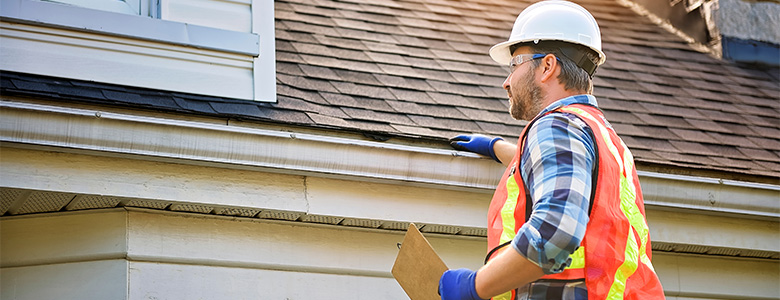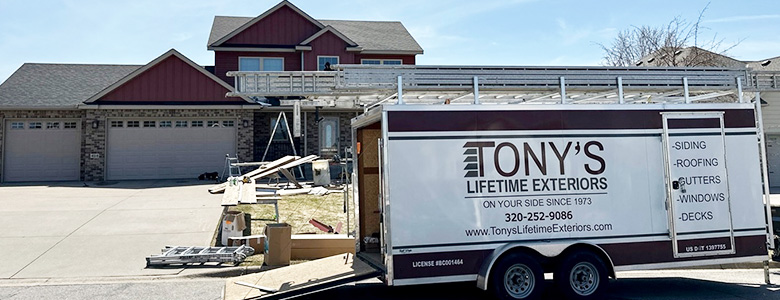What the Relationship Should Look Like With Your Roofer

It may initially seem silly to think of you and your roofer having a prolonged relationship. You might think, "Isn't a new roof a one-and-done thing?"
While roof installation is often completed in just a few days, replacing your roof has many stages – some of which involve more direct contact and interaction with the roofing company than others.
In our experience, building a relationship between the roofing contractor and the homeowner is critical to satisfaction with the overall experience and results (on both ends).
Regardless of the given stage of the project your roofer is currently on, they should treat you with respect. Find descriptions of that kind of respect here!
Stage 1: The Consultation
The "planning" stage is when your roofer scopes out the terrain. A representative will speak with you and determine what kind of shingles you're looking for, in what color, etc. Project timelines may also be discussed during this period.
You can also inspect an in-person visit, where the roofing contractor gets a better feel for the job. Since it's hard for homeowners to follow them up to where they'll be inspecting, they might take pictures to demonstrate.
Finally, your consultation includes an assessment and discussion about what materials (if any) from your current roof can be worked into your new one. Payment terms will be outlined.
What Makes a Professional Roofing Consultation?
Expect the pinnacle of professionalism during this stage! While the roofing contractor might not be performing any physical work, they are still doing business with you, and they should be held to the highest standard.

Mutual Respect
Even if your current roof is in shambles or you've made maintenance mistakes, you shouldn't be scoffed at by your contractor for it. Their job is to put a new roof on your home, not to judge your old one!
While current problems should be brought up and discussed with respect to future maintenance requirements and the project itself, they should not be used to make you feel ashamed and thus manipulate you into a sale.
The contractor must also be willing to answer any questions you may have about your future roof.
Punctuality
Extenuating circumstances aside, your contractor should be on time for their appointment; It's simply not good business practice to be late.
If they give you a window of time in which they will arrive, it should be sufficiently narrow to allow you to prepare for their presence without waiting around all day for it.
Stage 2: Getting to Work
In what's probably the most significant portion of the roofing process, the contractor rallies their team for the job. Shingles and similar materials will be transported to your home, and a dumpster will appear for refuse.
Your old roof is carefully stripped down to the timbers (framework) and then reconstructed. Rotten materials will be replaced, a waterproof barrier will be applied, and new shingles will be layered.
Remember that this portion of the process depends on the type of roof you have installed and the condition of your old roof. If you're curious about the step-by-step description, ask your roofer!
How Do Professional Roofers Act On the Job?
Efficiency and staying out of your way are the names of the game. While your roofing contractor can't be completely invisible (they have to hammer in shingles, after all!), they should take steps to make the process as minimally disruptive as possible for you.
Getting a project done on time should also be an evident priority!
-
All crew members on site should be friendly and professional.
-
Dilly-dallying should be nonexistent, but be mindful that taking required and much-needed breaks can come off as such.
-
Some safety equipment, such as scaffolding, should be in place to help workers do their jobs quickly and without fear.
-
The work area should be left clean at the end of the day.

Stage 3: Wrapping Up
After the last shingle is nailed in and the workers head home, your home should return to normal.
Your lawn should look as it once did, and the ground area around your roof should be immaculate – free of nails and debris.
How Professional Roofers Wrap Up a Project
It's a combination of making themselves scarce and remaining available by leaving you with the information you need to care for your roof.
-
They should have cleaned up so well that, aside from your awesome new shingles, there should be no sign you've just had roofing work done.
-
The landscaping should have been left in the same state before they set foot in your yard.
-
Your contractor should inform you how to take care of your new purchase (if they haven't already done so during the consultation stage).
-
If you have any issues with your purchase, your contractor should make it obvious what number to call.
Tips for Spotting Fraudulent Roofing & Siding Contractors
Tony's Lifetime Exteriors is proud to be a part of an industry of hardworking, honest exterior professionals. However, it's the exceptions that give roofers and siding contractors everywhere a bad rap and leave consumers with dangerously lackluster installations.
Unfortunately, they can be hard to spot for the untrained eye, so here are a few ways to know you are dealing with fraud.
Fraudulent Exterior Contractors: What Are They?
They're contractors that won't get you the service you pay for, obviously, but in this field, that tends to take a specific shape, perhaps due to that shape's effectiveness in fooling the unwitting homeowner.
Storm chasers, as fraudulent exterior contractors are often known, show up in roving bands after a neighborhood has gone through a severe storm. They go door to door, hawking their wares and supposed services, claiming that a given home has been severely damaged in the passing weather and that they're just the contractor to fix it.
While this might seem like a good thing, how convenient is having a helpful roofing or siding pro right on your doorstep? Yet these "professionals" are anything but.
They're Known to Use Pressure-Heavy Sales Tactics
Because storm chasers rely on the weather for their business (they follow severe storms, as their name suggests), losing a sale is a big deal for them. As we all know, Minnesotan weather can be unpredictable.
They often exploit a homeowner's vulnerability by showing up unannounced and leveraging:
-
Their apparent expertise
-
A homeowner's lack of knowledge about their own home
-
The apparent time-sensitive nature of the "damage"
-
A homeowner's courteousness (It's hard to shut the door in someone's face!)
-
The neighborhood's stress that inevitably follows a severe storm
And all this is often manipulated just in the name of making a sale! Once a storm chaser leaves your home, you're bound to feel exhausted after undergoing all that pressure.
We don't think that's any way to feel after a company you're paying does business with you.
They Often Do Shoddy Workmanship
Because they often use generic names and wander around so much, storm chasers are difficult, if possible, to hold accountable for the job that they do. This means that once they leave a property with their money, you're stuck with whatever quality roof or siding installation they choose to slap on your house.
And it's not in their best interests for that to be a good one since great customer reviews and ethics play little role in running an airtight scam. In fact, there have even been cases of storm chasers disappearing into thin air once they've gotten their money, leaving the poor homeowner high and dry.
While there may be honest door-to-door roofing contractors and siding installers out there, it's hard to tell them apart from storm chasers, so you risk hiring one based on their doorstep sales tactics.
Even if they are forthcoming about their services and do what they say they'll do, a homeowner should always choose a local company based on location and word of mouth/reviews for storm damage repair – not the first one that comes knocking.
If you have an issue after the job is done, you'll want to be able to track them down!
They Don't Provide Support
Once bad weather comes again, as it inevitably does, who will make sure your home's still on two feet, so to speak? Certainly not that storm chaser!
Because putting down roots and building a reputation off of great results doesn't suit them,
It's their MO to vanish after they've collected their money, never to be heard from again. They exist solely to make a profit, not to better their community's siding and roofing installations.
How Do I Know If I'm Dealing With a Storm Chaser?
They're hard to spot if you don't know what you're looking for, but it's as easy as pie once you do. After all, they're everything we at Tony's Lifetime Exteriors aren't!
-
They intrude on your time by showing up out of the blue instead of waiting for you to reach out.
-
They're focused on making a sale, not on your home's well-being.
-
They often use generic names (Storm Repair Experts) instead of more specific ones that contain the names of people or places.
-
They're pushy, rude, and self-centered instead of displaying a genuine concern for building the client-contractor relationship.
-
They clam up when asked about their team's credentials instead of proudly displaying how they operate.
-
You can't find anything about them online, and they don't have an official website.
Tony's Lifetime Exteriors: Your Local Roofing Pros
Time and time again, we've been there for our community after rough storms, rough patches, and rough years. With the numerous roofing and siding companies we consider brand partners and nearly entirely in-house team, we're the contractors you can trust.
We do everything from asphalt roofing installation to working on metal roofs, and no matter what you need to be done, our five-star reviews prove you can expect it to be done right!
Our team is ready to help, so contact us online or call our Sauk Rapids office today at 320-252-9086 to get started.